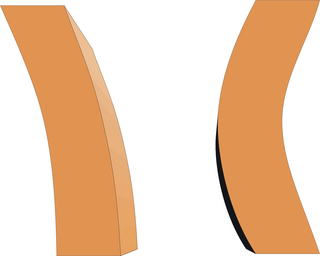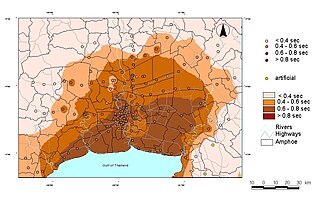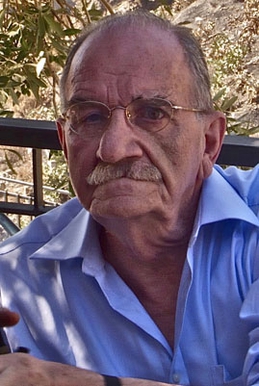Related Research Articles

Seismology is the scientific study of earthquakes and the propagation of elastic waves through the Earth or other planetary bodies. It also includes studies of earthquake environmental effects such as tsunamis as well as diverse seismic sources such as volcanic, tectonic, glacial, fluvial, oceanic, atmospheric, and artificial processes such as explosions. A related field that uses geology to infer information regarding past earthquakes is paleoseismology. A recording of Earth motion as a function of time is called a seismogram. A seismologist is a scientist who does research in seismology.

A seismic hazard is the probability that an earthquake will occur in a given geographic area, within a given window of time, and with ground motion intensity exceeding a given threshold. With a hazard thus estimated, risk can be assessed and included in such areas as building codes for standard buildings, designing larger buildings and infrastructure projects, land use planning and determining insurance rates. The seismic hazard studies also may generate two standard measures of anticipated ground motion, both confusingly abbreviated MCE; the simpler probabilistic Maximum Considered Earthquake, used in standard building codes, and the more detailed and deterministic Maximum Credible Earthquake incorporated in the design of larger buildings and civil infrastructure like dams or bridges. It is important to clarify which MCE is being discussed.

Seismic risk refers to the risk of damage from earthquake to a building, system, or other entity. Seismic risk has been defined, for most management purposes, as the potential economic, social and environmental consequences of hazardous events that may occur in a specified period of time. A building located in a region of high seismic hazard is at lower risk if it is built to sound seismic engineering principles. On the other hand, a building located in a region with a history of minor seismicity, in a brick building located on fill subject to liquefaction can be as high or higher risk.
Peak ground acceleration (PGA) is equal to the maximum ground acceleration that occurred during earthquake shaking at a location. PGA is equal to the amplitude of the largest absolute acceleration recorded on an accelerogram at a site during a particular earthquake. Earthquake shaking generally occurs in all three directions. Therefore, PGA is often split into the horizontal and vertical components. Horizontal PGAs are generally larger than those in the vertical direction but this is not always true, especially close to large earthquakes. PGA is an important parameter for earthquake engineering, The design basis earthquake ground motion (DBEGM) is often defined in terms of PGA.

Seismic retrofitting is the modification of existing structures to make them more resistant to seismic activity, ground motion, or soil failure due to earthquakes. With better understanding of seismic demand on structures and with our recent experiences with large earthquakes near urban centers, the need of seismic retrofitting is well acknowledged. Prior to the introduction of modern seismic codes in the late 1960s for developed countries and late 1970s for many other parts of the world, many structures were designed without adequate detailing and reinforcement for seismic protection. In view of the imminent problem, various research work has been carried out. State-of-the-art technical guidelines for seismic assessment, retrofit and rehabilitation have been published around the world – such as the ASCE-SEI 41 and the New Zealand Society for Earthquake Engineering (NZSEE)'s guidelines. These codes must be regularly updated; the 1994 Northridge earthquake brought to light the brittleness of welded steel frames, for example.

A response spectrum is a plot of the peak or steady-state response of a series of oscillators of varying natural frequency, that are forced into motion by the same base vibration or shock. The resulting plot can then be used to pick off the response of any linear system, given its natural frequency of oscillation. One such use is in assessing the peak response of buildings to earthquakes. The science of strong ground motion may use some values from the ground response spectrum for correlation with seismic damage.

Seismic analysis is a subset of structural analysis and is the calculation of the response of a building structure to earthquakes. It is part of the process of structural design, earthquake engineering or structural assessment and retrofit in regions where earthquakes are prevalent.
Earthquake engineering is an interdisciplinary branch of engineering that designs and analyzes structures, such as buildings and bridges, with earthquakes in mind. Its overall goal is to make such structures more resistant to earthquakes. An earthquake engineer aims to construct structures that will not be damaged in minor shaking and will avoid serious damage or collapse in a major earthquake. A properly engineered structure does not necessarily have to be extremely strong or expensive. It has to be properly designed to withstand the seismic effects while sustaining an acceptable level of damage.

National Center for Research on Earthquake Engineering is an organisation in Da'an District, Taipei, Taiwan.

Seismic microzonation is defined as the process of subdividing a potential seismic or earthquake prone area into zones with respect to some geological and geophysical characteristics of the sites such as ground shaking, liquefaction susceptibility, landslide and rock fall hazard, earthquake-related flooding, so that seismic hazards at different locations within the area can correctly be identified. Microzonation provides the basis for site-specific risk analysis, which can assist in the mitigation of earthquake damage. In most general terms, seismic microzonation is the process of estimating the response of soil layers under earthquake excitations and thus the variation of earthquake characteristics on the ground surface.
Ground–structure interaction (SSI) consists of the interaction between soil (ground) and a structure built upon it. It is primarily an exchange of mutual stress, whereby the movement of the ground-structure system is influenced by both the type of ground and the type of structure. This is especially applicable to areas of seismic activity. Various combinations of soil and structure can either amplify or diminish movement and subsequent damage. A building on stiff ground rather than deformable ground will tend to suffer greater damage. A second interaction effect, tied to mechanical properties of soil, is the sinking of foundations, worsened by a seismic event. This phenomenon is called soil liquefaction.
In geophysics, geology, civil engineering, and related disciplines, seismic noise is a generic name for a relatively persistent vibration of the ground, due to a multitude of causes, that is often a non-interpretable or unwanted component of signals recorded by seismometers.
The endurance time (ET) method is a dynamic structural analysis procedure for seismic assessment of structures. In this procedure, an intensifying dynamic excitation is used as the loading function. Endurance time method is a time-history based dynamic analysis procedure. An estimate of the structural response at different equivalent seismic intensity levels is obtained in a single response history analysis. This method has applications in seismic assessment of various structural types and in different areas of earthquake engineering.

Nicholas Neocles Ambraseys FICE FREng was a Greek engineering seismologist. He was emeritus professor of engineering seismology and senior research fellow at Imperial College London. For many years Ambraseys was considered the leading figure and an authority in earthquake engineering and seismology in Europe.

Earthquake rotational loading indicates the excitation of structures due to the torsional and rocking components of seismic actions. Nathan M. Newmark was the first researcher who showed that this type of loading may result in unexpected failure of structures, and its influence should be considered in design codes. There are various phenomena that may lead to the earthquake rotational loading of structures, such as propagation of body wave, surface wave, special rotational wave, block rotation, topographic effect, and soil structure interaction.

Medhat Haroun was an Egyptian-American expert on earthquake engineering. He wrote more than 300 technical papers and received the Charles Martin Duke Lifeline Earthquake Engineering Award (2006) and the Walter Huber Civil Engineering Research Prize (1992) from the American Society of Civil Engineers.

Rotational components of strong ground motions refer to variations of the natural slope of the ground surface due to the propagation of seismic waves. Earthquakes induce three translational and three rotational motions on the ground surface. To study the nature of strong ground motions, seismologists and earthquake engineers deploy accelerometers and seismometers at various distances from active faults on the ground surface or bedrock in order to record the translational motions of ground shaking. The corresponding rotational motions are, then, estimated in terms of the gradient of the recorded translational ground motions. Different methods may be adopted for the indirect estimation of the earthquake rotational components, such as time derivation and finite difference. Specialized instruments, such as gyroscopes and tiltmeters, which can detect small changes in the orientation of the ground surface, may be used to directly measure rotational ground motions. Currently, ring laser gyroscopes are widely used to measure the amplitude of rotational movements of the ground surface.
In continuum mechanics, viscous damping is a formulation of the damping phenomena, in which the source of damping force is modeled as a function of the volume, shape, and velocity of an object traversing through a real fluid with viscosity.

Michael C. Constantinou is an American structural engineer who is a Samuel P. Capen Professor and State University of New York Distinguished Professor in the Department of Civil, Structural and Environmental Engineering at the University at Buffalo. He also serves an editor of the Journal of Earthquake Engineering and Structural Dynamics
Andrew Stuart Whittaker is an American structural engineer who is currently a SUNY Distinguished Professor in the Department of Civil, Structural and Environmental Engineering at the University at Buffalo, State University of New York.
References
- 1 2 Vamvatsikos D., Cornell C.A. (2002). Incremental Dynamic Analysis. Earthquake Engineering and Structural Dynamics, 31(3): 491–514.
- 1 2 Kiani, Jalal; Pezeshk, Shahram (2017). "Sensitivity analysis of the seismic demands of RC moment resisting frames to different aspects of ground motions". Earthquake Engineering & Structural Dynamics. 46 (15): 2739–2755. doi:10.1002/eqe.2928. ISSN 1096-9845. S2CID 96452142.
- ↑ SAC/FEMA (2000). Recommended seismic design criteria for new steel moment-frame buildings, Report No. FEMA-350, and Recommended seismic evaluation and upgrade criteria for existing welded steel moment-frame buildings, Report No. FEMA-351, SAC Joint Venture, Federal Emergency Management Agency, Washington, DC.
- ↑ Luco N., Cornell CA. (1998) Effects of random connection fractures on demands and reliability for a 3-storey pre-Northridge SMRF structure. Proceedings of the 6th U.S. National Conference on Earthquake Engineering, paper 244, Seattle, WA.
- ↑ Baker, Jack W.; Allin Cornell, C. (25 July 2006). "Spectral shape, epsilon and record selection". Earthquake Engineering & Structural Dynamics. 35 (9): 1077–1095. CiteSeerX 10.1.1.585.7815 . doi:10.1002/eqe.571. ISSN 1096-9845. S2CID 426019.
- ↑ Bradley, Brendon A. (1 September 2013). "A critical examination of seismic response uncertainty analysis in earthquake engineering". Earthquake Engineering & Structural Dynamics. 42 (11): 1717–1729. doi:10.1002/eqe.2331. hdl: 10092/8700 . ISSN 1096-9845. S2CID 59370811.
- ↑ Kiani, Jalal; Khanmohammadi, Mohammad (19 May 2015). "New Approach for Selection of Real Input Ground Motion Records for Incremental Dynamic Analysis (IDA)". Journal of Earthquake Engineering. 19 (4): 592–623. doi:10.1080/13632469.2014.997901. ISSN 1363-2469. S2CID 110763954.
- ↑ Lin, T. and Baker, J. W. [2013] "Introducing Adaptive Incremental Dynamic Analysis: A new tool for linking ground motion selection and structural response assessment,” 11th International Conference on Structural Safety & Reliability, New York.